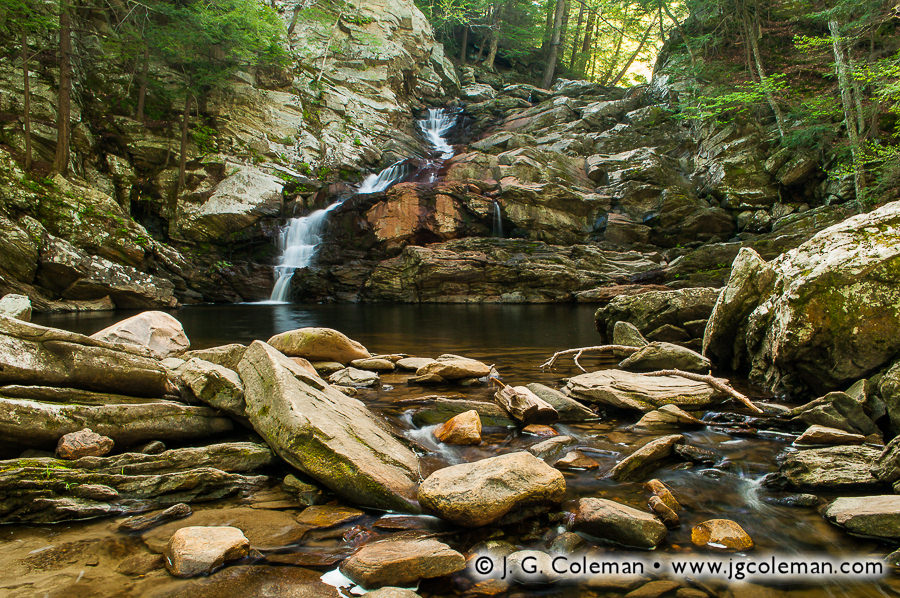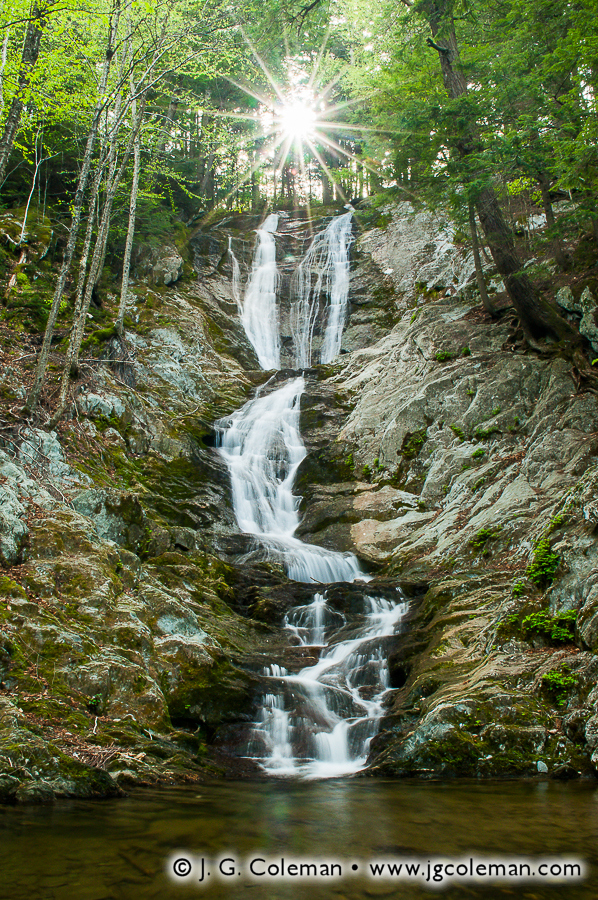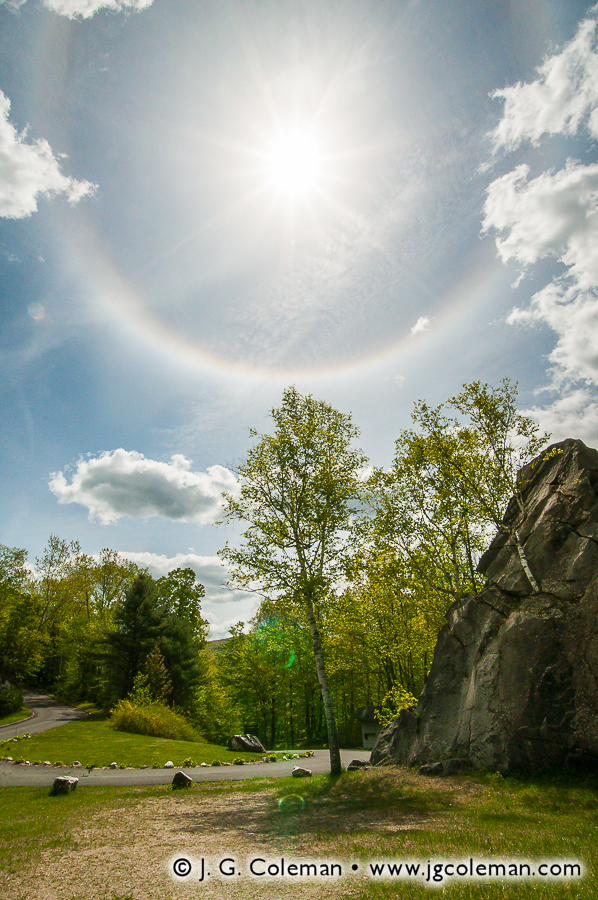
Wahconah Falls State Park, Dalton, MA
© 2013 J. G. Coleman
Last week, for the first installment of my three-part series Journey Into the Berkshires, I introduced you to a few of my latest fine art prints featuring the most time-honored natural landmarks of the region. We began at the lofty heights of Mount Greylock, then descended into the shadowy, woodland chasm of Bash Bish Falls. In this second installment, our Berkshire odyssey continues as we delve into places that are perhaps lesser known, but equally stirring and graced with uncommon wild beauty.
Wahconah Falls
Dalton, Massachusetts
We begin our journey by venturing into my new piece, Nessacus Fortune (top), which brings us into the geographic heart of the Berkshires where Wahconah Brook is churned to whitewater as it spills over successive tiers of ancient bedrock. In the foreground, the lively brook fans out as it slips around slabs of fragmented marble. Hardy cliff-side trees and a glancing taste of the distant, glowing forest canopy remind us that this exquisite landscape of stone is actually crowded by dense woodlands.
Known as Wahconah Falls, there is an interesting Native American legend associated with this 40-foot cascading waterfall that comes to us from several different books published throughout the late 1800s. In fact, the story of Wahconah has been written, re-written and re-interpreted so many times that it’s difficult to pin down any one version of the story as the “original”. In some cases, the story is condensed into a single paragraph, while in other books it is related in long form and occupies nearly ten pages. Rarely does one find a local legend that is told with such diversity of size and detail. And, since it is so eloquently related elsewhere at great length, I offer here a fairly abbreviated account.
The tale begins during King Philip’s War in the mid-1670s, a tumultuous time when a broad confederation of tribes in Central and Eastern Massachusetts were engaged in routine combat with the English, trying to push the foreigners out of their territory. Further west, near what we know today as Wahconah Falls, lived a tribe under the leadership of one Chief Miacomo. Miacomo had opted not to involve his people in the grizzly conflict, instead remaining hidden deep in the Berkshires where the English could not find them. And so it was that his daughter, Wahconah, could enjoy relative peace in the tribe’s hideaway in the mountains.

Wahconah Falls State Park
Dalton, MA
© 2013 J. G. Coleman
From time to time, though, warriors tired from battle would slip into the hills and stumble upon Miacomo’s village. They were always welcome to stay for some time and rest, though none of them proved so problematic as a warrior named Nessacus. During his stay at the village, Nessacus fell deeply in love with Wahconah and eventually asked the chief for permission to marry her.
Chief Miacomo favored Nessacus, but he was urged by the tribal priest, Tashmu, to offer Wahconah’s hand in marriage to an old Mohawk warrior instead. Tashmu insisted that such an arranged marriage would promote an alliance between Miacomo’s tribe and the neighboring Mohawk tribe. Secretly, though, the priest simply craved the political influence he would gain under such an alliance; he had little regard for the desires of Wahconah and no interest in the likes of Nessacus.
The tribe looked to Miacomo for a ruling of some kind, but he was unable to come to a decision even after days of consideration. Amidst growing tensions and the prospect of a duel, Tashmu intervened and explained that he had visions in which a vacant canoe would be launched from the foot of the nearby waterfall and left to drift downstream to a point where a large boulder divided the waters of the river equally. Nessacus and the old Mohawk would stand on opposite sides of the river near the boulder and, depending upon which side of the boulder the canoe drifted, that suitor would win Wahconah’s hand.
Little did the tribespeople know, Tashmu and the Mohawk secretly tried to rig the event by digging out the stream bed to hasten the flow of water on the Mohawk’s side of the boulder. Surely, they believed, the swifter current would draw the canoe towards the Mohawk and victory would be guaranteed. The next day, the tribe assembled to watch as Nessacus and the Mohawk assumed their positions on either side of the boulder. A canoe was released upstream and the two suitors stood in wait as it floated down the river, approaching ever closer. The Mohawk’s jaw nearly dropped, however, as he watched the canoe take an unswerving course for the opposite side of the boulder, ensuring that love would prevail and Nessacus and Wahconah would be wed. Baffled, the Mohawk set off into the forest on his way back to his home village. Tashmu, surely just as awestruck at the development, stormed out of the village shortly afterwards.
Various renderings of the tale differ on the point of how Tashmu and the Mohawk somehow failed despite their best efforts at cheating. In some cases, no attempt is made to explain the outcome, leaving us to believe that it was the Great Spirit, or perhaps the magical strength of true love, that managed to draw the canoe towards Nessacus. In other instances, it is suggested that Nessacus may have anticipated that his competitors would cheat, affording him an opportunity to secretly counter their efforts. One version of the story recounts that, days after the event, a tribesman discovered evidence that Nessacus had affixed a makeshift rudder to the bottom of the canoe, ensuring that it would steer towards his own side of the boulder regardless of the tug of the currents. Yet when the man reported his findings to Chief Miacomo, the elder didn’t seem especially concerned…
Nessacus and Wahconah were happily wed, and so it is that Wahconah Falls draws its name from a tale of romance. But what ever became of Tashmu? Most versions of the story agree that he was infuriated after his botched attempt at gaining political influence. Hungry for revenge, Tashmu traveled for a few days until reaching the nearest English army, offering to guide them to Miacomo’s village. Incidentally, the English didn’t act upon Tashmu’s invitation, for they were low on supplies and needed to head back east. But Native American spies had caught on to Tashmu’s treachery and brought word back to Miacomo and Nessacus that their hidden location in the hills had been revealed to the English and was no longer safe. Tashmu was swiftly hunted down and put to death for treason, some say by Nessacus himself. The village was presumably moved shortly afterwards, though if any of the English ever did discover the new location, that information has been lost to history.
Tannery Falls
Florida, Massachusetts
Our next stop brings us further north to Savoy, a rural town of 36 square miles and just over 700 people. Practically empty relative to most of Southern New England, it is no surprise that the vast majority of Savoy is blanketed with sprawling expanses of unbroken woodlands. In fact, roughly a third of the town’s entire land area is preserved within four state forests!

Tannery Falls, Savoy Mountain State Forest, Florida, MA
© 2013 J. G. Coleman
Savoy Mountain State Forest is the namesake open space, occupying more than 10,000-acres of mountainous wilds in the heart of the town. It is here that we find Tannery Falls, a towering waterfall on Ross Brook that is featured in my new work, Sanctuary at Savoy Mountain. As we explore this piece, we are drawn at first to the blazing sun star piercing the forest canopy at the precipice of the waterfall. From there, Tannery Falls begins its first descent, fanning out into two broad sheets as it slides down a smooth marble rock face. Successive whitewater cascades form the lower half of the fall, heaving the waters of Ross Brook from side to side until reaching a calm, dark pool below. Tannery Falls is surely one of the most aesthetically remarkable waterfalls in the Berkshires, perhaps even rivaling the much acclaimed falls at Bash Bish.
Of course, it’s easy to forget that my actual experience at Tannery Falls didn’t necessarily comport with the image of peaceful solitude that you might envision when you look at Sanctuary. During my visit in May, the mosquitoes had emerged en masse and were so unforgiving in their relentless assault that it required an act of willpower just to stand in one spot long enough to compose a shot. By the time I was packing up my camera gear, every bit of exposed skin was aching from their ceaseless bites. Truth be told, though, the beauty of Tannery Falls is arresting; so much so that I was more than obliged to offer a hearty meal to the local mosquito population in return for the privilege of producing Sanctuary at Savoy Mountain.
But a word of advice: if you should ever find yourself traveling through Savoy in search of springtime sanctuary, just be sure to remember insect repellent and long sleeves…
A Halo at Natural Bridge?
North Adams, Massachusetts
Natural Bridge State Park may get less attention than nearby Mount Greylock, but that’s probably just because folks don’t know what they’re missing. The namesake feature of this 48-acre park is a large, natural arch comprised entirely of marble; the only such arch on the continent. Furthermore, visitors that walk a short way upstream from the arch will find the only dam on the continent made entirely of marble. For my own part, though, I was most intrigued by the 60-foot deep gorge through which Hudson Brook flows beneath the arch. The narrow, winding gorge brought to my mind the iconic slot canyons of the American Southwest, except that instead of red-rock sandstone, the smooth canyon walls of Natural Bridge are carved entirely from pale gray, half-billion-year-old marble bedrock. Before I saw the canyon of Natural Bridge, I never would’ve imagined that such a place existed in New England.

Natural Bridge State Park, North Adams, MA
© 2013 J. G. Coleman
That being said, you might be surprised to learn that my piece from Natural Bridge State Park, titled Halo Over North Adams, doesn’t portray any of the impressive attractions that I’ve just described. As fate would have it, what were originally partly cloudy skies had cleared while I was en route to the park, leaving me instead with cloudless skies and harsh, direct sunlight that wasn’t especially conducive to photographing the various marble rock formations. But just when I thought that Natural Bridge wouldn’t yield any particularly interesting images, Mother Nature conspired to reveal beauty in a most unexpected way.
Believing that interesting opportunities for photography might be found within the shadows of the gorge, where harsh sunlight couldn’t penetrate, I and a fellow shooter ventured up Hudson Brook. We eventually found ourselves in a shallower end of the narrow marble canyon, flanked on both sides by vertical cliff faces that climbed some 25 feet above our heads to gorge rim. The terrain leading further into the canyon proved impassable on foot, however, dashing any hopes of making it into the depths we had originally set out to access. But as we lingered for a moment before turning back, we happened to glance upwards. Only a narrow sliver of the sky was visible from the canyon floor, but we were amazed to see what appeared to be a strange rainbow emanating from the Sun. I wondered if perhaps we weren’t just experiencing some peculiar optical illusion caused by sunlight funneling into such a narrow crevice, but as we eagerly made our way out of the canyon and into the open parkland, we gazed up in amazement at a hazy halo that fully encircled the Sun.
Neither of us had ever witnessed such a phenomenon and had no idea how long it might last, so we wasted no time composing several frames of the otherworldly scene. My favorite piece from that fortuitous shoot, Halo Over North Adams, portrays the broad halo as it appeared over the landscaped park road of Natural Bridge. The winding road, trees, and monolithic rock outcropping all lend a much needed sense of scale to this image, illustrating the colossal breadth of the halo as it appeared overhead.
Known most commonly as “sun halos”, these 360° rainbows form only when sunlight passes though atmospheric ice crystals under just the right circumstances. Although they are fairly uncommon, they are by no means unheard of, for whenever they do happen to appear over a heavily populated area, they tend to generate plenty of commotion. Unusual atmospheric phenomena such as sun halos and rainbows are the true wildcards of landscape photography; photogenic occurrences that are just as elusive as they are impressive. There is really no way to conclusively predict them, and if you don’t already have your camera in-hand once you’ve spotted them, you’re probably too late!
The Journey Continues…
With the second installment of Journey Into the Berkshires coming to a close, we’ve already explored a good deal of Massachusetts’ mountainous west through an array of my new works. If I could venture to draw any underlying thread from the images and stories here, it is that the wildlands of the Berkshires, in the true character of wildness, have no regard for the narrow expectations of man. Against all odds, these mountains saw fit to grant Nessacus with victory. These mountains summoned hordes of mosquitoes to try and drive this humbled photographer out of the valleys of Savoy. These mountains, it seems, can even reach to the ceiling of the heavens and affix a halo to the Sun itself!
But perhaps it’s this vein of unpredictability that we find in the Berkshires which draw us into these remote and rugged places. As author Robert MacFarlane reminds us: “At bottom, mountains, like all wildernesses, challenge our complacent conviction – so easy to lapse into – that the world has been made for humans by humans. Most of us exist for most of the time in worlds which are humanly arranged, themed and controlled. One forgets that there are environments which do not respond to the flick of a switch or the twist of a dial, and which have their own rhythms and orders of existence. Mountains correct this amnesia.”
Be sure to join me in a few weeks for the third and final installment of Journey Into the Berkshires, when we’ll come down from the heart of this grand mountain range and explore the natural wonders that abound in its foothills and borderlands.
Want to See More?
- To buy a fine art print of any of the pieces seen above, or my other pieces from these locations, visit my gallery pages for Wahconah Falls, Savoy Mountain & Tannery Falls and Natural Bridge State Park.
- Read the third and final installment of Journey Into the Berkshires.

